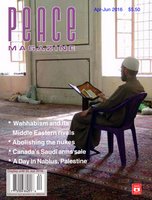
Peace Magazine Apr-Jun 2016, page 23. Some rights reserved.
Search for other articles by Janet Nicol here
After more than two decades of dangerous, expensive, and exhausting work, Mozambique celebrated its status as a mine-free nation last year—the first country anywhere to do so. Among the brave de-miners who cleared the east African country of explosive devices was Helen Gray.
Gray, now a staff member at the Geneva International Centre for Humanitarian Demining (GICHD), says in an interview with Peace, that “de-miner fatigue” can set in and the work can feel endless. De-miners need to be “invigorated” to get the job done. “There has to be political will,” she observes, for otherwise the task of ridding the country of land mines can “run on.”
In 2004, Gray was just 24 years old when she left her home in Scotland and signed on to the British-based HALO (Hazardous Areas Life-Support Organization) Trust.1 She spent two years as a de-miner in Angola and then transferred to Mozambique, where she trained teams. When I interviewed her for New Internationalist magazine in 2009, Gray and other de-miners, most local residents, had destroyed more than 100,000 mines and the four northern provinces were mine-free.
HALO Trust employed more than 1,600 Mozambicans over the 22 year period and is credited with eradicating about 80 per cent of all the country’s explosive devices. Funding for salaries, equipment and other costs came from many countries.
“It is important to hire local people so the salaries go back into the communities,” Gray says. “The job gets done when local people are doing it. It gives the community faith in the process.”
Mozambique had been at war for more than two decades, starting in 1977, in a struggle for independence against Portuguese colonizers. The fighting evolved into civil war as opposing groups competed to take government control. More than 900,000 people died. Five million civilians were displaced. Thousands of soldiers and civilians lost limbs from land mines, tragedies which would have continued if de-miners hadn’t appeared.
“In the early 1990s there were 600 accidents a year,” Gray says. “By 2013, there might have been three accidents.”
Gray credits the National Deminers Institute (NDI) in Mozambique for its determination to work with HALO, as well as APOPO, a Belgium NGO, and other groups. “It’s about good partnerships too,” she says.
Working six days a week, de-mining requires people with steady nerves. First the area is surveyed and de-miners speak to community members, many who know where the mines are. After mapping out the area, a team of 10 people, four having paramedic skills, don face shields with bullet-proof vests before heading into the field.
The de-miners mark the area with lines of red sticks and using metal detectors, de-mine along clear wide strips, inch by inch. The teams start at 6:00 AM and finish at 1:00 PM, working 50 minutes and taking 10 minute breaks.
The safety record among de-miners in Mozambique has been high, Gray says. “It’s important to stay within the rules,” she explains. “If there is an accident, we investigate to find out what went wrong.”
“It was a challenge to finish,” Gray adds. “You have to keep the momentum among the de-mining teams. People realize they are going to be worked out of a job.”
A re-training program has helped HALO de-miners move on. Many have attended technical colleges and studying mechanics or agriculture. Others are committed to international work, training de-miners in other countries such as Cambodia.
After the de-mining work was complete, Gray says it was necessary for the NDI to train two police officers in each district to deal with potential discoveries of explosives.
Gray now travels to other war-ravaged countries to share best practises with de-miners. She also returns to Mozambique, where she has made close friends. She says with pride, “I am hopeful for their future.”
Janet Nicol is a teacher and activist in British Columbia.
1 The HALO website is at www.halotrust.org

Peace Magazine Apr-Jun 2016, page 23. Some rights reserved.
Search for other articles by Janet Nicol here